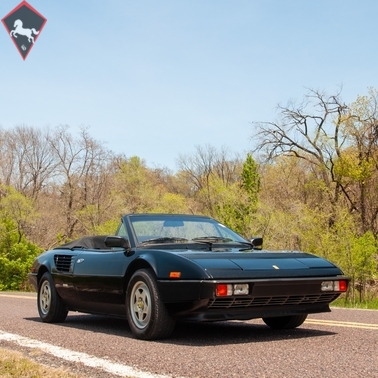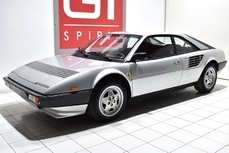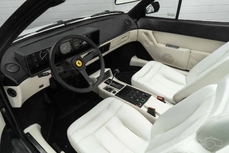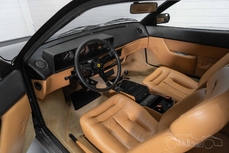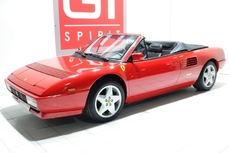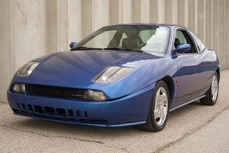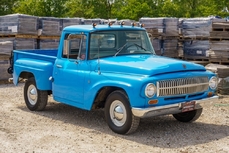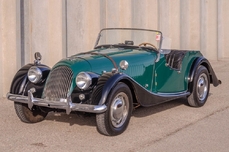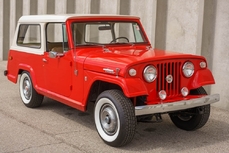Ferrari Mondial 3.0L DOHC 32-valve V-8 1984
General description :
1984 Ferrari Mondial QV Cabriolet
Low mileage, understood to be 35,000 miles
Extremely rare Mondial model: this is just 1 of 629 cabriolets made between 1983 and 1985
3.0L, Tipo, DOHC 32-valve V-8 engine (code F105E040) with Bosch K-Jetronic fuel injection
Five-speed manual transmission with gated shifter
Triple Black (code 1240) exterior with black soft-top and black interior with matching Connolly Leather seats and boot
Previous owner performed a mechanical refresh worth more than $7,000 performed in December 2016Cleaned fuel systemReplaced timing belts, seals, rollers, water pump, thermostat, spark plugs and valve cover gasketsRebuilt starterRecently serviced brakesRepaired Nuovolare exhaust
Cleaned fuel system
Replaced timing belts, seals, rollers, water pump, thermostat, spark plugs and valve cover gaskets
Rebuilt starter
Recently serviced brakes
Repaired Nuovolare exhaust
$3,000 spent on interior refresh
Momo three-spoke steering wheel, rack-and-pinion steering and power four-wheel, ventilated disc brakes, power windows and power locks
Toolkit from a Ferrari 400i
Accident-free CarFax report
Another prancing horse has arrived at MotoeXotica Classic Cars, this time in the form of a rarely seen 1984 Ferrari Mondial QV Cabriolet. In fact, only 629 Mondial Cabriolets were made between 1983 and 1985.
Made in Maranello, Italy, this car’s triple black (code 1240) exterior is in overall great condition, with a few blemishes visible upon close inspection. The car’s windows are clear and crack-free, including the soft-top’s rear window. This Ferrari rolls on Michelin TRX radials, size 240/55VR390, surrounding original Ferrari wheels with flat centers and pronounced edges to the five spokes. All wheels feature a yellow circular center cap bearing Ferrari’s black Cavallino Rampante rearing-horse logo. The tires and wheels are in satisfactory order, with the passenger side wheels evidencing some slight blemishes upon close inspection.
This car’s bodywork is straight and the bumpers look great but do show some imperfections, the engine bay tucked behind the cabin is quite tidy and the forward cargo area looks good.
Tucked in that engine bay is a Ferrari-cast lightweight alloy 3.0L DOHC 32-valve V-8 engine with shrink-fit cylinder liners; a five-bearing, flat-plane crankshaft with paired connecting rods on each journal; belt-driven, quad overhead camshafts (two per cylinder bank) acting directly on the valves; alloy crossflow cylinder heads; and a wet-sump lubrication system. This motor feature a cast-alloy intake housing nestled centrally above the engine “vee,” with manifold tubing running directly to each cylinder. Marelli electronic ignition is used and comprises twin coils, a separate distributor run off each bank of cylinders and a common electronic control module. Fuel metering is via Bosch K-Jetronic continuous fuel injection with lambda exhaust sensing. Exhaust gases on all models are collected via 4-2-1 systems fitted to the outside of each cylinder bank, flowing through one or two catalytic converters to twin outlets each side of the rear panel.
The previous owner spent more than $7,000 giving the car a mechanical refresh in December 2016. The fuel system was cleaned, the car has new timing belts, seals, rollers, a water pump, a thermostat, spark plugs and valve cover gaskets, plus a rebuilt starter, recently serviced brakes and repaired Nuovolare exhaust system. Driver convenience features include power brakes, power locks and power windows. Additionally, the car has just had the AC fully serviced with a new AC compressor and charged with R134.
Mated to that V-8 is a five-speed, all-indirect manual transmission using a “dog-leg” selector pattern was the only transmission offered. Instead of the conventional “H” shift pattern, this arrangement (also known as a “reverse h-gate”) has first gear situated to the far left and back, behind reverse. This pattern has been popular with racing gearboxes, as it allows quicker, more direct shifts between second, third, fourth and fifth gears. Output from the final drive to the rear wheels is via a pair of short, solid drive shafts fitted with constant-velocity joints at each end to allow for suspension articulation.
The transmission housing is integral with the engine sump casting, albeit with its own oil supply, sitting below and slightly to one side of the main block. Drive to the gearbox is via a single-plate, diaphragm-spring clutch and a set of drop-gears located outboard of the left-hand end of the crankshaft, with output torque feeding into a friction-plate limited-slip final drive unit offset to the rear of the gearbox. For these models, clutch actuation is hydraulic, unlike their two-seater cousins’ cable systems, and transmission selection is via a rod which extends through the center chassis tunnel and passes through the engine sump into the transmission housing.
Suspension systems are fully independent all-round, comprising unequal-length upper and lower wishbones, coil-over damper units and anti-roll bars at each end. Steering is an unpowered rack-and-pinion mechanism sitting ahead of the front wheels. Braking is via four-wheel ventilated disks with split-circuit vacuum assistance.
Inside, the seats and interior are fully trimmed in black Connolly leather, with the exception of the use of black vinyl for the dashboard top and upper door linings. A previous owner spent about $3,000 refreshing the interior and it looks great. The power antenna is inoperable. All seats, including those in the rear, are strongly bucket-shaped and fitted with inertia-reel seat-belts. The matching carpet is in similar shape to the seats, the inner door panels are in great shape, as are the center console and mirror glass.
A central tunnel for the chassis is prominent in both front and rear foot wells and is straddled by a large front center console with a polished open-gated gear selector and electronic warning-light panel. Electric windows (the front panes only are opening) are standard fitments with their controls on the central console. A three-spoked Momo steering wheel is mounted to a steering column adjustable for reach and rake, behind which is a “pod-style” instrument binnacle holding six gauges – speedometer, tachometer, fuel level, water temperature, oil pressure and oil temperature. The Mondial instrumentation is completed with a comprehensive set of warning lights and electronic check panels. Rounding out this interior is a Kenwood AM/FM stereo with CD player.
The Mondial name (French for world or global) originated from Ferrari’s motor racing history — the 500 Mondial was a successful lightweight sports racer, which was named to celebrate Ferrari’s consecutive Formula 1 World Championships in 1952 and 1953. The name was revived as Ferrari won the Formula 1 World Championships in 1975, 1976, 1977 and 1979. Conceived as a ‘practical’ Ferrari, the Mondial is a genuine long-distance four-seater, with sufficient rear head- and legroom for children and smaller adults. It affords easy access via the long single doors and has surprisingly good all-round visibility for a mid-engined car.
Competition to this Ferrari in 1984 included Aston Martin’s Volanté, Chevrolet’s Camaro Convertible, Jaguar’s XJ-SC Cabriolet, Maserati’s Biturbo Spyder, Mercedes-Benz’s 500 SL, Pontiac’s Firebird Convertible and Porsche 911 3.2 Cabriolet.
This car is currently located at our facility in St. Louis, Missouri. Current mileage on the odometer shows 35,925 miles and is understood to be actual. It is sold as is, where is, on a clean and clear, mileage exempt title. GET OUT AND DRIVE!!!
Check out our YouTube video of this Ferrari here!
VIN: ZFFUC15A7E0051875
https://www.motoexotica.com/inventory/listing/1984-ferrari-mondial-qv-cabriolet/
1984 Ferrari Mondial 3.0L DOHC 32-valve V-8 is listed sold on ClassicDigest in Fenton (St. Louis) by for $42900.
Car Facts
Car type : Car Make : Ferrari Model : Mondial Model Version : 3.0L DOHC 32-valve V-8 Engine size : 3.0 Model Year : 1984 Sub type : Convertible Location : Fenton (St. Louis)
Sold
Seller Information
Sold
People who viewed this Ferrari Mondial also viewed similar Ferrari listed at ClassicDigest
Other cars listed for sale by this dealer
About Ferrari
The first Ferrari road car was the 125 S introduced in 1947 and powered by a 1.5 L V12 engine, right? Well it's not quite that simple, Ferrari did in fact produce e Tipo 815, in 1940. Tipo 815 was designed by ex-Alfa Romeo engineers Alberto Massimino and Vittorio Bellentani and by Enrico Nardi under Enzo's company but legal issues with the former associate Alfa Romeo prevented Ferrari from launching the Ferrari marque at that point.
Enzo did produce a series of fine road cars in the 50's and 60's but they were merely to finance his true passion racing, wheather GT/Sports car or Grand Prix. The 50's saw the birth of Ferrari's most memorable cars, 250 GTB (tour de France) 250 Testa Rossa, 250 GT swb just to name a few.
Under the surface tension was growing though. In November 1961 long-time sales manager Girolamo Gardini made an ultimatum to Enzo: if tensions continued, he would leave the company. As a result, Gardini was ousted, as well as Scuderia Ferrari manager Romolo Tavoni, chief engineer Carlo Chiti, experimental sports car development chief Giotto Bizzarrini, and a number of others who stood by them.
Without Chiti and Bizzarrini the development of what was to become the most quintessential Ferrari and today the world's most expensive car, 250 GTO, was at a pivoting point. 250 GTO project was saved by a young engineer Mauro Forghieri and long-time racing bodyman Sergio Scaglietti who stepped in and took over the program with known results.
In addition to 250 GTO, Ferrari launced such master pieces as 250 LM, 250P, 275 GTB, 365 GTB/4 "Daytona" during the the 60's
By the late 60's Ferrari's prototypes' success came to a sudden halt by a new competitor, GT40. Ford turned to Lola to produce a Ferrari beating long distance racer after Enzo had cut the deal off with Henry Ford II making the latter absolutely boil with fury. The collaboration between Ford and Lola created the mighty Ford GT40 that gave Ferrari some heavy hits in Le Mans 24 to come.
By the end of the 60's FIAT purchased 50% of the company, starting a development that has led to a new mass-produced era of Ferraris.
Whether you are selling or looking for a classic Ferrari www.classicdigest.com is the place to check out.
